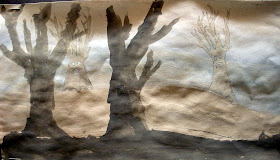As a kid, we always went on little educational adventures. Nana and Papa brought us to numerous museums and parks, including visits to of homes of past presidents. Now as an adult, I think museums and house tours are getting up there with brewery tours as one of my favorite things to do. Of course, the art teacher in me is also appreciative of a nice little art museum! This winter break, I was able to enjoy a great house with beautiful grounds AND an art museum, all with my Mom and Nana in the warmth of the Florida sun.
To me, the
Ringling Art Museum is like a hidden gem. Its really more than just an art museum too! I had no idea what to expect, in fact it was either Mom or Nana who asked
me if it was going to be all art about the circus. (First of all, this was Nana's idea and second of all, do I really want to spend a day looking at circus art!?) I wasn't even sure if it was the same Ringling let alone where Sarasota was in relation to where I was staying. I knew nothing! And was pleasantly surprised.
Come to find out, it
is the same Ringling as in the Ringling Brother's Circus. In one of the buildings on the grounds, which was the old art museum, there was an informative half hour video about the life of John and Mable Ringling. Both came from nothing. Before the stock market crash and the Great Depression, John had made some good investments, including real estate in Florida, and was the youngest brother of the successful Ringling Brother's Circus. He and his wife Mable taught themselves about art and began collecting. Also, like Isabella Stewart Gardner up here in Boston, the Ringlings designed a Venetian pallazo which was their winter residence. After Mable died young and the economy took a down turn, John refused to sell their art collection, even though he was pressured. When John Ringling died, their art collection, home and grounds were given to the city of Sarasota for all to enjoy.

The first building we went to, above, was the circus museum. An amazing artist (whose name I can't remember) built an entire miniature circus. The detail was incredible! It was encased in glass and the lights even dimmed to simulate night, and visitors could walk around to see every aspect of unloading, preforming and reloading the circus. I read
Water for Elephants about a year ago and it was cool to compare my visual images to what I was seeing in the miniature. I was surprised to see the book in the gift shop on the way out too!
The next building was even cooler. There was a refurbished train car that was once John and Mable Ringling's car. Seeing the train car in person really brought to life many of the scenes I read in Water for Elephants. Plus, I have been reading a few other books that have taken place between the 1900s and 1930s where a lot of train traveling takes place. I'm fascinated!
But then there was more in there! In another room there were life size wagons with the signs advertising the side shows.
That kind of circus art was cool!
Then Mom and Nana got nostalgic because there the wagons that were used when the circus would bring the parade through town. I don't ever remember seeing these, but the craftsmanship was gorgeous!
Then there was the pallazo.
Mable really took over this project and as the video told us, she spared no detail. I don't know if I could ever live in it, but it was nice to day dream and think myself a part of the Great Gatsby.
AND THEN, there was the art museum.
At this point we had already been on the grounds for hours, with a little picnic lunch at the car (only later did we realize there were tables). I enjoyed walking through the sculpture garden. I also appreciated that in each gallery there were laminated cards with information about the images and sculptures. Nana wanted to catch a tour from a docent. I usually don't mind a docent, but this one went on and on and on. Nana did a great job keeping up and looking interested, but I was getting tired. Much of the collection is also religious in nature or Baroque. It felt like freshman year art history all over again. But, how amazing that these pieces were collected by one man! Try to check out the link at the beginning of the post. You'll be impressed.
This was probably my favorite piece. The curators even painted the gallery to match and hung a chandelier like the one in the image, just above the piece.
There are four or five Rubens in the collection! Massive paintings filled with symbolism.
Creative use of the bougainvillea!
Such an awesome day.
And I got to use my student discount to boot. Four awesome places for five bucks!
And thanks to my mom for many of the photos in this post!











































